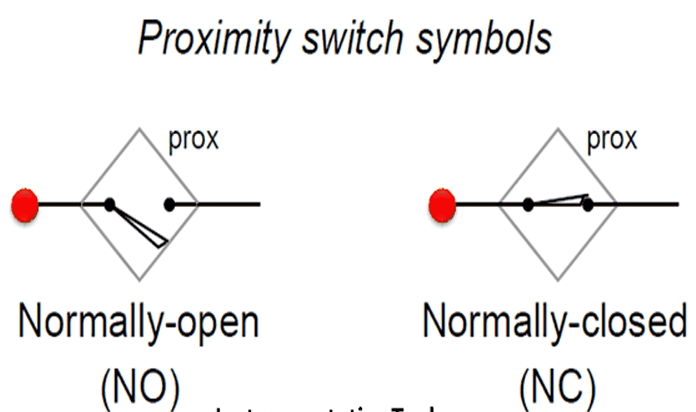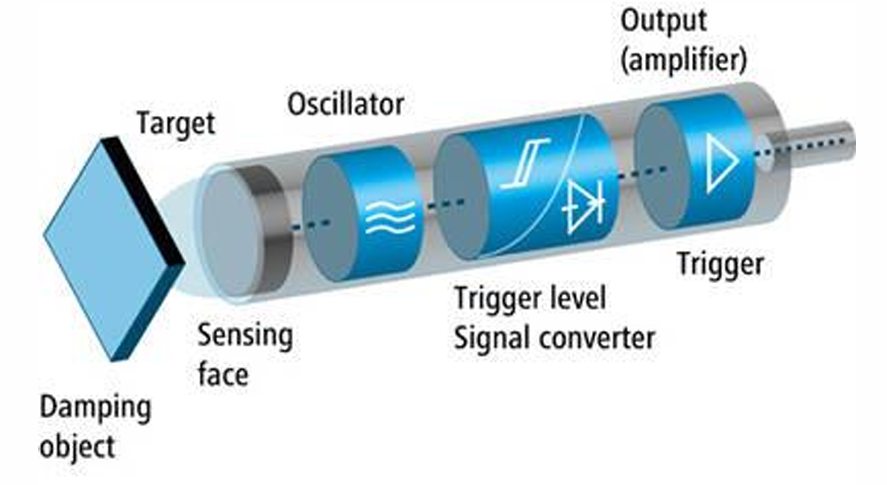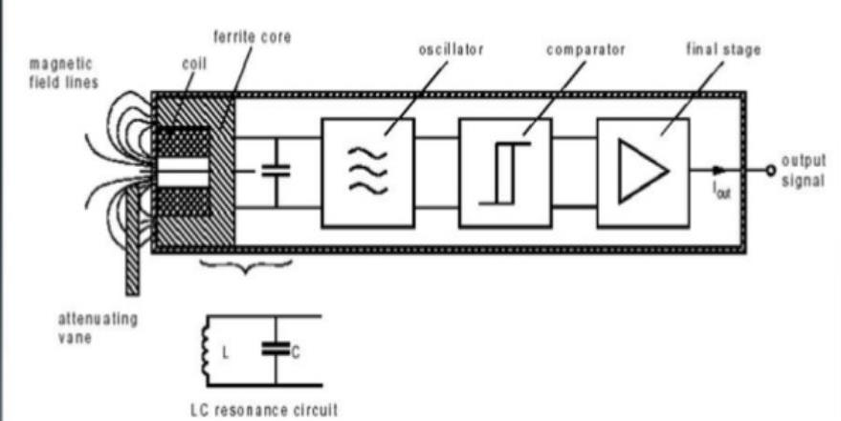M&D.A 7: Proximity Sensors
1/14
There's no tags or description
Looks like no tags are added yet.
Name | Mastery | Learn | Test | Matching | Spaced |
|---|
No study sessions yet.
15 Terms
What is a proximity sensor, and how does it differ from a limit switch?
What are the benefits of using proximity sensors?
A proximity sensor detects the presence of nearby objects without physical contact, often separated by a non-contact element like glass or plastic.
Unlike limit switches, which require physical contact and can wear out, proximity sensors offer adaptive controls, improved robustness, and design flexibility.
Give three real-world examples of proximity sensor applications.
Smartphones: Disable accidental touch events during calls.
Parking sensors: Use ultrasonic detectors to alert drivers to obstacles.
Automatic doors: Use optical, weight, or electric field sensors for contact-free access.
What is a proximity switch, and what are its main types?
A proximity switch is a non-contact sensor that detects the closeness of objects using magnetic, electric, optical, or ultrasonic means.
Main types include:
inductive (metallic objects)
capacitive (non-metallic objects)
optical (light beam interruption)
ultrasonic (sound wave reflection) switches.
How are proximity switches represented in circuit diagrams?

How do proximity switches operate, and what is the role of the LC Resonant oscillator?
The sensor circuit detects nearby objects and sends a signal to a transistor-based driver circuit (NPN or PNP). The LC Resonant oscillator generates oscillations that change when a metal object is near, allowing the sensor to detect its presence.
what are the differences between NPN (sinking) and PNP (sourcing) outputs?
difference: NPN (sinking) switches connect the emitter to the negative rail and sink current, while PNP (sourcing) switches connect the emitter to the positive rail and source current.

What are the four main types of proximity sensors, and what does each detect?
Inductive: Detects metallic objects using electromagnetic fields.
Capacitive: Detects non-metallic objects using electric fields.
Ultrasonic: Detects dense matter by reflecting sound waves.
Optical: Detects objects by interrupting a light beam.
Explain the operating principle of inductive proximity sensors and why they only detect metallic objects.
🔄 Faraday’s Law (Basics):
Faraday’s Law says: If the magnetic field near a wire changes, it causes a voltage (electricity) in the wire.
This is the principle behind how transformers and electric generators work.
🌀 Inductive Proximity Sensors:
Inductive sensors use this principle to detect metal objects without touching them.
Here’s what happens inside an inductive proximity sensor:
Oscillator and Coil:
The sensor has an oscillator (which produces a high-frequency AC signal) connected to a coil of wire.
This creates a magnetic field that radiates out from the coil.
Metal Comes Near:
When a metal object gets close to the magnetic field, the metal reacts.
It doesn’t need to be magnetized — it just has to conduct electricity (like iron, aluminum, copper, etc.).
Eddy Currents:
The metal object has electrons that start swirling around due to the changing magnetic field.
These swirling currents are called eddy currents.
Energy Loss / Attenuation:
The eddy currents use up energy from the sensor’s magnetic field.
This reduces the strength of the oscillation in the sensor’s circuit.
Detection:
The sensor detects that the oscillation is getting weaker.
This change is interpreted as the presence of a metal object nearby.
🧠 Simple Analogy:
Imagine waving your hand in water (the magnetic field). If you bring a sponge (metal object) close, it soaks up energy, and your wave feels weaker — that’s how the sensor "knows" something’s there. Only metals interact with the field, so non-metals are not detected.
How does the type, shape, and size of a metallic target affect the sensing distance of an inductive proximity sensor?
Ferromagnetic metals like steel have the longest sensing distances, while non-ferrous metals like aluminum or copper have shorter ranges. The shape and size of the target also influence the operating distance.
Why are inductive proximity sensors suitable for dirty environments, and what contaminants can affect their operation?
They are resistant to dirt, dust, smoke, oil, grease, or soot between the sensor and target, and build-up on the sensor face does not affect operation. However, metallic contaminants like chips can impact performance.

Describe the main components and working stages of an inductive proximity sensor.
Main components: Coil, Oscillator, Detector, Output Circuit.
The coil generates a magnetic field; a metallic target absorbs energy, affecting the oscillator.
The detector and threshold circuit sense this change, and the output circuit (NPN/PNP transistor) drives the load ON or OFF.

What is the typical sensing range and directionality of inductive proximity sensors?
The sensing range is typically less than 6 cm, and the sensor has no directionality.
List three advantages and two disadvantages of inductive proximity sensors.
Advantages: High accuracy, high switching rate, can work in harsh environments.
Disadvantages: Can only detect metallic targets, limited operating range.
Give three common applications of inductive proximity sensors.
Metal detectors, car washes, and automated industrial processes, especially where physical contact is difficult or dirt is prevalent.
Describe an alternative construction method for a proximity inductive sensor.
A wound coil is placed in front of a permanent magnet, encased in a rugged housing. A change in current in the coil, caused by a metallic object, is output through leads to signal detection.